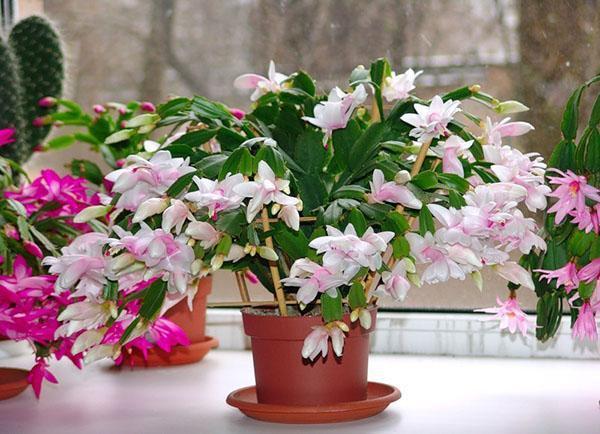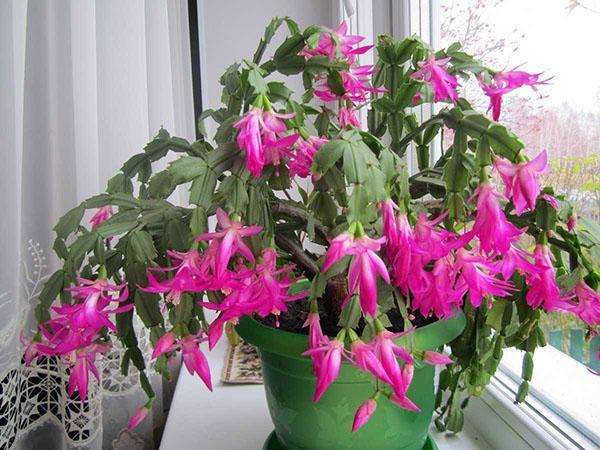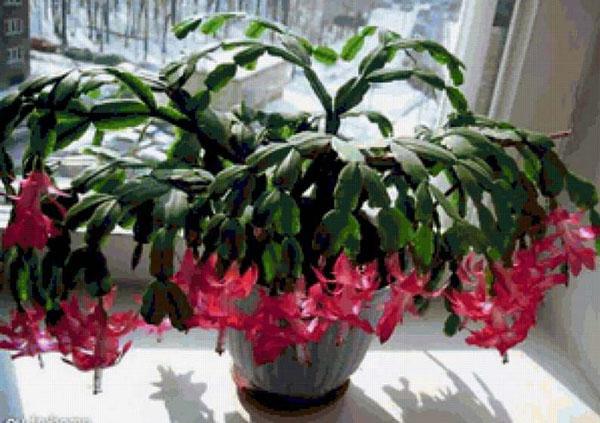Choosing one of the types of zygocactus for your home
 Today you will learn about zygocactus, the species, photos and names of which are presented in this article. This is a magnificent flower that still stood on the windowsills of our grandmothers, but has not lost its popularity to this day due to the fact that many interesting and bright varieties have been bred.
Today you will learn about zygocactus, the species, photos and names of which are presented in this article. This is a magnificent flower that still stood on the windowsills of our grandmothers, but has not lost its popularity to this day due to the fact that many interesting and bright varieties have been bred.
The plant has a second, popular, name - Decembrist. It comes from the flowering period - December, January.
Read also about orchid Wanda!
Description of zygocactus

Blooms, as a rule, profusely. The peculiarity of the flowers is the petals in several tiers. This distinguishes the Decembrist from the relative of Ripsalidopsis. The color of the buds is white, pink, crimson.
Home maintenance
Schlumberger's zygocactus is one of the unpretentious plants for home growing. By following a few simple rules, you can get a blooming specimen in winter.
 Location. Prefers a bright place, but no direct sun. Coasters are ideal next to windows, east or west. If there is little light, the plant does not bloom or produces a few weak buds.
Location. Prefers a bright place, but no direct sun. Coasters are ideal next to windows, east or west. If there is little light, the plant does not bloom or produces a few weak buds.
 Humidity. Since this is a representative of the forest fauna, it needs high humidity. Nearby, you can install saucers with water, moss, and spray the Decembrist.
Humidity. Since this is a representative of the forest fauna, it needs high humidity. Nearby, you can install saucers with water, moss, and spray the Decembrist.
Watering is moderate, the earth should dry out a couple of centimeters. It is especially important to keep an eye on watering in winter to prevent root rot.
Water is taken filtered and warm.
Top dressing is carried out when there is active growth and flowering. It is carried out approximately once a month. The fertilizer dose is half that for fast growing flowers. During the rest period, they do not feed.
Pruning. Produced after flowering, which stimulates the growth of new shoots and a more abundant appearance of buds in the future, since it blooms on young branches.
 Transfer done rarely, old specimens are enough once every 4-5 years, very young - annually. The pot is taken shallow, but wide. The soil is light, it includes: leafy, soddy soil, peat and sand are added for looseness, bark for air permeability, and charcoal for disinfection. This allows you to bring the content closer to the conditions of the natural environment. At the bottom of the tank, drainage is needed, for which expanded clay is used. After transplanting, watering is done in a few days.
Transfer done rarely, old specimens are enough once every 4-5 years, very young - annually. The pot is taken shallow, but wide. The soil is light, it includes: leafy, soddy soil, peat and sand are added for looseness, bark for air permeability, and charcoal for disinfection. This allows you to bring the content closer to the conditions of the natural environment. At the bottom of the tank, drainage is needed, for which expanded clay is used. After transplanting, watering is done in a few days.
Reproduction
 As a rule, it is easy to propagate the Decembrist zygocactus. For these purposes, you need to break off a branch with 2-4 leaves. They should be dried a little and then set in loose soil, perlite or sand. After the roots appear, it can be transplanted into the main container, but it should not be too large. Instead of soil, you can put the leaves in water.
As a rule, it is easy to propagate the Decembrist zygocactus. For these purposes, you need to break off a branch with 2-4 leaves. They should be dried a little and then set in loose soil, perlite or sand. After the roots appear, it can be transplanted into the main container, but it should not be too large. Instead of soil, you can put the leaves in water.
Bloom
 Flowering problems are associated with improper organization of the dormant period. Budding begins when daylight decreases, from September to November. It matters if the temperature drops to 13-18 degrees before flowering. Watering is also reduced at this time.
Flowering problems are associated with improper organization of the dormant period. Budding begins when daylight decreases, from September to November. It matters if the temperature drops to 13-18 degrees before flowering. Watering is also reduced at this time.
The plant must constantly find a place and not move it, otherwise the Schlumberger will drop its buds.
From May to August, there is an active growth, it is recommended to bring the Decembrist to the balcony or garden.
Types of zygocactus
There are several varieties in the rooms:
- Truncated zygocactus. The segments of the plant are small, serrated along the edge, the length of the segment is 4-6 cm, the length of the flowers is 6-8 cm, the diameter is 4-6 cm. The height of the plant is up to 50 cm. The color of flowers is pink, crimson. Truncated zygocactus is one of the most common in rooms and offices.

- Zygocactus Russeliana. Lower grade, up to 30 cm in height, shoots up to 1 meter. The flowers are tubular and come in different shades. The edges of the leaves are wavy.

- Zygocactus Buckley. The color of the leaves is darker, the height of the plant is 40-50 cm. The flowers are large, up to 8 cm, pink, purple shades. The leaves are small, the projections of the edges are not very pronounced. Many people know the name of this type of zygocactus, its photos are also common.

Diseases and pests
 Like any house plant, the Decembrist sometimes gets sick.
Like any house plant, the Decembrist sometimes gets sick.
The most common pests:
- spider mite;
- mealybug;
- thrips.
The preparations of fitoverm, aktara, actellik help from them (it is used with caution at home).
Excessive watering, cold content leads to stem rot.
Thus, zygocactus, the scientific name of the Decembrist, has different types that can be recognized from the photo. For a home, this is a fairly simple plant; even a novice florist can grow it.